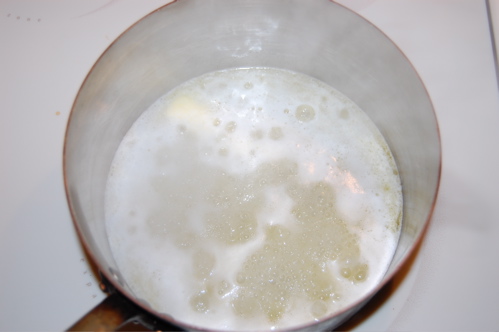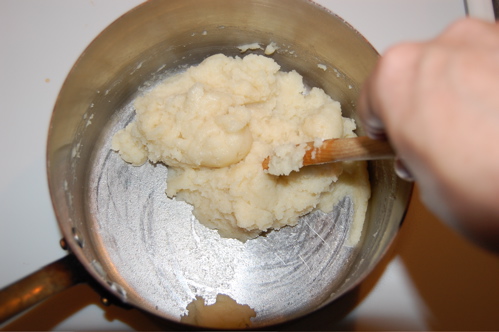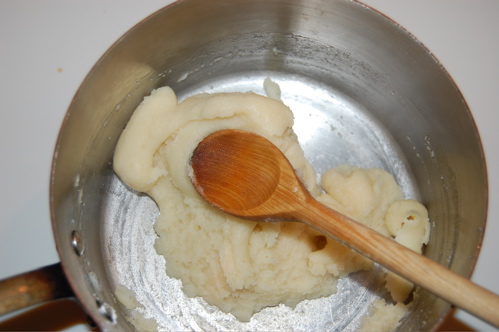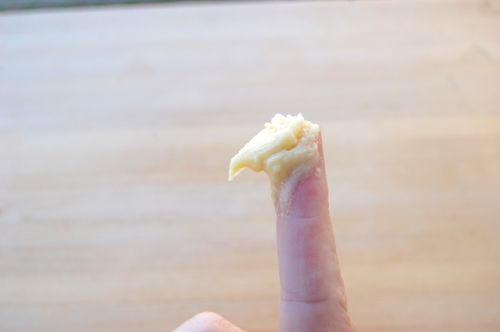Making Ze Choux
Did I remember to say it’s pronounced like “shoe”?
No matter. Making choux is a simple process, mostly just stirring. The traditional method is to simply use a wooden spoon, though a lot of people use food processors nowadays. Me, I can’t tell much of a difference between the methods, so I figure, why dirty a food processor? The things are a pain to clean.
Start by bringing your water, butter, salt and sugar to a boil. Try not to keep this up for too long, since moisture is important to the consistency of the dough/batter.

Once you’ve got your mixture boiling, add your flour. Here you can see I sifted mine since sifted flour is less likely to clump.

Take the pan off the heat and stir the mixture into a paste.

Now comes the very important cooking stage, where you gelatinize the starch. You want to return the mixture to medium heat and cook it until it a.) becomes semi-smooth and blobby, and b.) a thin film of cooked flour starts to stick to the pan. Once you see that happening, start the three-minute clock and continue the stirring.

When the three minutes are up it’s time to turn the choux out into a bowl. Let it sit for two or three more minutes to cool a bit, then start adding your eggs. Just add one…

…stir until it’s incorporated…

…add another…

…stir and so on until you’ve added all your eggs and the mixture is completely smooth. If your eggs extra are extremely large, just add three to start.

Why? Because the right amount of moisture is important to a choux batter, and there’s an easy way to check. Dip your finger in and pull it away so the batter makes a little point. Hold the point up so it sticks out horizontally. The very tip should droop down like this.

If it sticks out perfectly straight, add more egg. Say, just a white, or part of one…since too much egg will ruin your batter. Know an overly moist choux batter again by the dip test. The point will flop straight down. In that case, pitch what you have, start again and chalk it up to experience.
Any…where’s my pastry bag?
Hi Joe,
I have been trying to make those pate a choux twice:
the first time, it didnt raise up
the second time, it’s raised up at the top but not the bottom.
And they are very eggy.
Im french leaving in Singapore and missing french patisserie, Im trying to make them myself as I can not find any good french patisserie here.
Please help..
Cheers 🙂
Hello Zizou! I would be happy to help. Tell me about the flour that is available there. Can you find anything European?
Hi Joe,
Thanks for your awesome blog, I love all the info and science behind each type of dessert. I used your pao de queijo recipe and for once did not make hockey pucks, it was heaven! I know for the pao de queijo, the dough can be formed into balls, frozen and then baked right out of the freezer at a later date. Since there are so many similarities in the making process of the dough for pao de queijo and pate choux, can I also form pate choux into balls (for cream puffs), freeze, then just pop into the oven at a later date when I want some cream puffs?
P.S. I’ll be trying your japanese cheesecake recipe soon, I’ve tried to make it before and it came out dense and gummy. Yours sounds much better.
P.P.S Can you tackle Chinese egg tarts with the puff pastry shell sometime soon? I’ve made Chinese egg tarts very successfully with a short crust, and in nostalgic longings for the NYC ones with the flaky crust, decided to try subbing a crust made with store bought puff pastry (haven’t worked up the courage to laminate my own dough yet) for my shell and it was a disaster.
Hey, Deb! And thanks very much!
You can pipe an freeze the batter if you like. I find baking and freezing more convenient, but either way works.
Let me know on the cheesecake, and I’ll look into those tarts!
– Joe
Can you post the recipe again i clicked on the link to it and it didn’t work
Hey Melyssa!
It’s right here: http://joepastry.com/category/pastry-components/choux/standard-choux/
Cheers,
– Joe